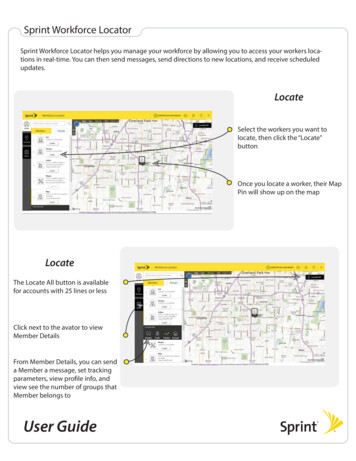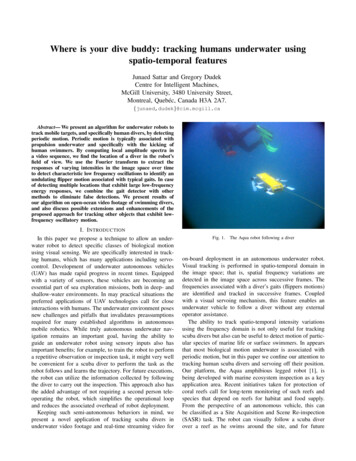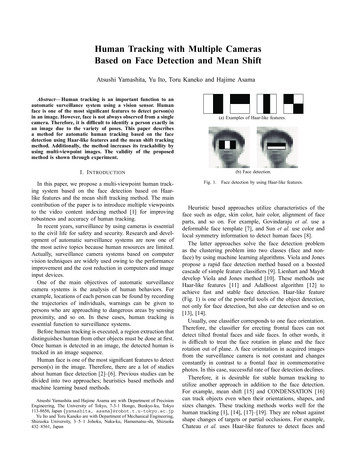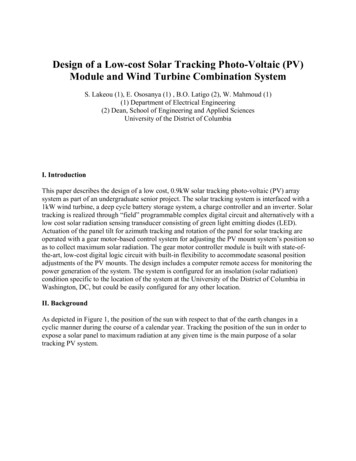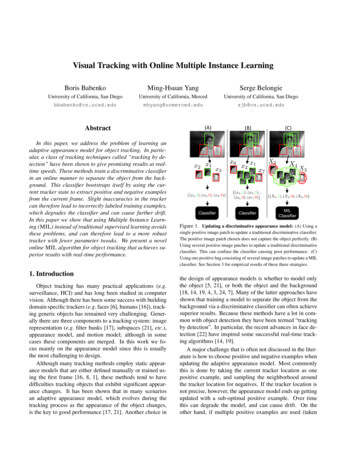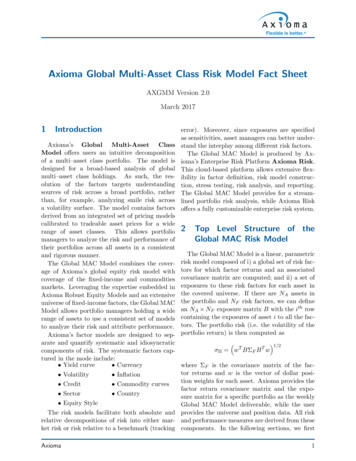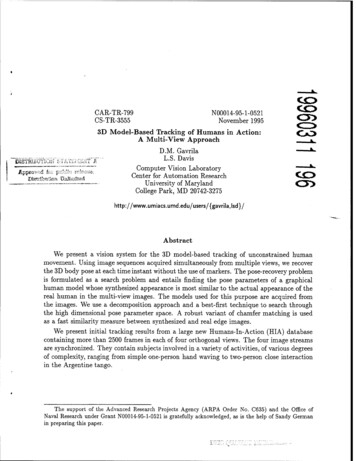
Transcription
CAR-TR-799CS-TR-3555N00014-95-1-0521November 19953D Model-Based Tracking of Humans in Action:A Multi-View ApproachD.M. Gavrila"WSfRL-C . . i" .w- J H,pf»«P;; Il«teil35j'Soa Uafefe L S- -DavisComputer Vision LaboratoryCenter for Automation ResearchUniversity of MarylandCollege Park, MD ,lsd}/AbstractWe present a vision system for the 3D model-based tracking of unconstrained humanmovement. Using image sequences acquired simultaneously from multiple views, we recoverthe 3D body pose at each time instant without the use of markers. The pose-recovery problemis formulated as a search problem and entails finding the pose parameters of a graphicalhuman model whose synthesized appearance is most similar to the actual appearance of thereal human in the multi-view images. The models used for this purpose are acquired fromthe images. We use a decomposition approach and a best-first technique to search throughthe high dimensional pose parameter space. A robust variant of chamfer matching is usedas a fast similarity measure between synthesized and real edge images.We present initial tracking results from a large new Humans-In-Action (HIA) databasecontaining more than 2500 frames in each of four orthogonal views. The four image streamsare synchronized. They contain subjects involved in a variety of activities, of various degreesof complexity, ranging from simple one-person hand waving to two-person close interactionin the Argentine tango.The support of the Advanced Research Projects Agency (ARPA Order No. C635) and the Office ofNaval Research under Grant N00014-95-1-0521 is gratefully acknowledged, as is the help of Sandy Germanin preparing this paper.
THIS DOCUMENT IS BESTQUALITY AVAILABLE.THECOPY FURNISHED TO DTICCONTAINED A SIGNIFICANTNUMBER OF PAGES WHICH DONOT REPRODUCE LEGIBLY.
1IntroductionThe ability to recognize humans and their activities by vision is a key feature in the pursuit ofdesigning machines capable of interacting intelligently and effortlessly in a human-inhabitedenvironment. Besides this long-term goal, many applications are possible in the relativelynear term, e.g. in virtual reality, "smart" surveillance systems, motion analysis in sports,choreography of dance and ballet, sign language translation, and gesture-driven user interfaces. In many of these applications a non-intrusive sensory method based on vision ispreferable over a method (in some cases not even feasible) that relies on markers attachedto the bodies of human subjects.Our approach to looking at humans and recognizing their activities has two major components:1. body pose recovery and tracking2. recognition of movement patternsSeveral choices have to be made in connection with body pose determination and tracking,which affect what features can be used: the type of model used (stick figure, volumetricmodel, none), the dimensionality of the space in which tracking takes place (2D or 3D),the number of sensors used (single, stereo, multiple), the sensor modality (visible light,infrared, range), the sensor placement (centralized vs. distributed) and mobility (stationaryvs. moving). We consider the case where we have multiple stationary (visible-light) cameras,previously calibrated, and we observe one or more humans performing actions from multipleviewpoints. The aim of the first component of our approach is to reconstruct from thesequence of multi-view frames the (approximate) 3D body pose(s) of the human(s) at eachtime instant; this serves as input to the movement recognition component. In an earlierpaper [6] movement recognition was considered as a classification problem and a DynamicTime Warping method was used to match a test sequence with several reference sequencesrepresenting prototypical activities. The features used for matching were various 3D jointangles of the human body.In this paper, we focus on the pose recovery and trackingcomponent of our system.1
The outline of this paper is as follows. Section 2 provides a motivation for our choiceof a 3D recovery approach rather than a 2D approach. In Section 3 we discuss 3D humanmodeling issues and the (semi-automatic) model acquisition procedure used by our system.Section 4 deals with the pose recovery and tracking component. Included is a bootstrappingprocedure to start the tracking or to re-initialize it if it fails. Section 5 presents new experimental results in which successful unconstrained whole-body movement is demonstratedon two subjects. These are initial results1 derived from a large Humans-In-Action (HIA)database containing two subjects involved in a variety of activities, of various degree of complexity. We discuss our results and possible improvements in Section 6. Finally, Section 7contains our conclusions.22D vs. 3DOne may question whether it is desirable or feasible to try to recover 3D body pose from 2Dimage sequences for the purpose of recognizing human movement. An alternative approach isto work directly with 2D features derived from the images. Model-free 2D features are usuallyobtained by applying a motion-detection algorithm to the image (assuming a stationarycamera) and obtaining the outline of a moving object, presumably human. Frequently, aK xN spatial grid is superimposed on the motion region, after a possible normalization of itsextent. In each of the K x N tiles a simple feature is computed, and these are combined toform a K xN feature vector to describe the state of movement at time t. This is the approachtaken by Polana and Nelson [23] and Darrell and Pentland [4]. Another possibility is to use2D model-based features, where the assumption is that as a result of 2D segmentation andtracking a sequence of 2D stick figure poses is available. For example, Goddard [8] usesthe 2D angular velocities and orientations of the links as features. Guo et al. [10] uses acombination of link orientations and joint positions of the stick figure.Recognition systems using 2D model-free features have had early successes in matchinghuman movement patterns. For constrained types of human movement (such as walkingparallel to the image plane, involving periodic motion), many of these features have beenxThe tracking results described in this paper are also available as video clips from our home pages.2
successfully used for classification, as in [23]. This may indeed be the easiest and best solution for several applications. But we find it unlikely that reliable recognition of moreunconstrained and complex human movements (e.g. humans wandering around, making gestures while walking and turning) can be achieved using these types of features exclusively.With respect to using 2D model-based features, we note that few systems actually derivethe features they use for movement matching. Self-occlusion makes the 2D tracking problemhard for arbitrary movements and thus existing systems assume some a priori knowledge ofthe type of movement and/or the viewpoint under which it is observed [1, 19]. 2D labelingand tracking under more general conditions is attempted by [16].We therefore investigate in this paper the more general-purpose approach of recovering 3Dpose through time, in terms of 3D joint angles defined with respect to a human-centered [17]coordinate system. 3D motion recovery from 2D images is often an ill-posed problem. In thecase of 3D pose tracking, however, we can take advantage of the available a priori knowledgeabout the kinematic and shape properties of the human body to make the problem tractable.Tracking also is well supported by the use of a 3D human model which can predict eventssuch as (self) occlusion and (self) collision. Once 3D tracking is successfully completed, wehave the benefit of being able to use the 3D joint angles as features for movement matching,which are viewpoint independent and directly linked to the body pose. Compared with 3Djoint coordinates, they are less sensitive to variations in the size of the human.The techniques described in this paper lead to tracking on a fine scale, with the obtainedjoint angles being within a few degrees of their true values. Besides providing meaningfulgeneric features for a movement matching component, such techniques are of independentinterest for their use in virtual reality applications. In other applications, such as surveillance,continuous fine-scale 3D tracking will not always be necessary, and can be combined withtracking on a more coarse level (for example, considering the human body as a single unit),changing the mode of operation from one to another depending on context. For related workby Intille and Bobick see [13].
33D body modeling and model acquisition3D graphical models for the human body generally consist of two components: a representation for the skeletal structure (the "stick figure") and a representation for the fleshsurrounding it. The stick figure is simply a collection of segments and joint angles with various degree of freedom at the articulation sites. The representation for the flesh can eitherbe surface-based (using polygons, for example) or volumetric (using cylinders, for example).There is a trade-off between the accuracy of representation and the number of parametersused in the model. Many highly accurate surface models have been used in the field ofgraphics [2] to model the human body, often using thousands of polygons obtained fromactual body scans. In vision, where the inverse problem of recovering the 3D model from theimages is much harder and less accurate, the use of volumetric primitives has been preferredto "flesh out" the segments because of the lower number of model parameters involved.For our purposes of tracking 3D whole-body motion, we currently use a 22-D OF model(3 DOF for the positioning of the root of the articulated structure, 3 DOF for the torsoand 4 DOF for each arm and each leg), without modeling the palm of the hand or thefoot, and using a rigid head-torso approximation. See [2] for more sophisticated methods ofmodeling. Regarding shape, we felt that simple cylindrical primitives (possibly with ellipticXY-cross-sections) [5, 11, 25] would not represent body parts such as the head and torsoaccurately enough. Therefore, we employ the class of tapered super-quadrics [18]; theseinclude such diverse shapes as cylinders, spheres, ellipsoids and hyper-rectangles. Theirparametric equation e (eie2e3) is given by [18]/e aaiC*C?X(1)where — TT/2 u 7r/2, —7r v 7r, and where Sg sign(sin#) sin# , and C\ —sign(cos#) cos0 . In (1), a 0 is a scale parameter, 01,02,03 0 are aspect ratio parameters, and e1? e2 are "squareness" parameters. Adding linear tapering along the z-axis to the
super-quadric leads to the parametric equation s (siS2s3) [18]: — 1 ) eiaa3s .aa3 1 e2esV(2)/where —1 tx,t2 1 are the taper parameters along the x and y axes. So far, we haveobtained satisfactory modeling results with these primitives alone (see experiments); a moregeneral approach also allows deformations of the shape primitives [18, 21].In this work, we derive shape parameters Sk {ak,a\, a\, a , e , e t\,t\) from the projections of occluding contours in two orthogonal views, parallel to the zx- and zy-planes.This involves the human subject facing the camera front ally and sideways. We assume 2Dsegmentation of the two orthogonal views; a way to obtain such a segmentation is proposedin recent work by Kakadiaris and Metaxas [15]. Back-projecting the 2D projected contoursof a quadric gives the 3D occluding contours, after which a coarse-to-fine search procedureis used over a reasonable range of parameter space to determine the best-fitting quadric.Fitting uses chamfer matching (see the next section) as a similarity measure between thefitted and back-projected occluding 3D contours. Figure 1 shows frontal and side views ofthe recovered torso and head for two persons: DARIU and ELLEN. Figure 2 shows theircomplete recovered models in a graphics rendering. These models are used in the trackingexperiments of Section 5.4Pose recovery and trackingThe general framework for our tracking component is adapted from the early work by Rourkeand Badler [26] and is illustrated in Figure 3a. Four main components are involved: prediction, synthesis, image analysis and state estimation. The prediction component takes intoaccount previous states up to time t to make a prediction for time 1. It is deemed morestable to do the prediction at a high level (in state space) than at a low level (in imagespace), allowing an easier way to incorporate semantic knowledge into the tracking process.The synthesis component translates the prediction from the state level to the measurement(image) level, which allows the image analysis component to selectively focus on a subset of5
Figure 1: Frontal and side views of the recovered torso and head for the DARIU and ELLENmodels.if» Figure 2: The recovered 3D models ELLEN and DARIU say "hi!"regions and look for a subset of features. Finally, the state-estimation component computesthe new state using the segmented image.The above framework is general and can also be applied to other model-based trackingproblems. In the remainder of this section, we discuss how the components are implementedin our system for the case of tracking humans, and how this relates to existing work. In
POSE ESTIMATEPOSE PREDICTION -3-D AMERAVIEW IVIEW IVIEW NVIEWNSYNTHESISESTIMATIONSIMILARITYN(a)(b)Figure 3: (a) Tracking cycle; (b) pose-search cycle.the first subsection we cover the pose estimation component; the second subsection brieflycovers the other components.4.1Pose estimationOne approach to pose recovery is to derive point matches between a 3D figure and its 2Dprojection to solve for the former, perhaps using several images. The advantage of this isthat rigorous mathematical analysis can be applied to solve for the 3D pose; the problemcan be solved using techniques borrowed from inverse kinematics (see the precursor to [24]),constrained optimization [29], or algebraic geometry [12]. On the downside, this approachrequires feature points (usually the joints) to be accurately located in the images, which isquite difficult. Moreover, the approach seems to be very sensitive to occlusion.We therefore pursued an alternative approach to pose recovery, based on a generate-andtest strategy. Here, the pose recovery problem is formulated as a search problem and entailsfinding the pose parameters of a graphical human model whose synthesized appearance ismost similar to the actual appearance of the real human (see Figure 3b). This approachhas the advantage that the measure of similarity between synthesized appearance and actualappearance can now be based on whole contours and/or regions rather than on a few points.7
So far, existing systems which work on real images using this strategy have had limitations.Perales and Torres [22] describe a system which involves input from a human operator.Hogg [11] and Rohr [25] deal with the restricted movement of walking parallel to the imageplane, for which the search space is essentially one-dimensional. Downton and Drouet [5]attempt to track unconstrained upper-body motion, but conclude that the tracking failsdue to propagation of errors. Recent work by Goncalves et al. [9] uses a Kalman-filteringapproach to track arm movements from single-view images where the shoulder remains fixed.Finally, work by Rehg [24] is geared towards finger tracking. We aim to improve the previousapproaches, where applicable, along the following lines.Similarity measureIn our approach the similarity measure between model view and actual scene is based onarbitrary edge contours rather than on straight line approximations (as in [25], for example);we use a robust variant of chamfer matching [3]. The directed chamfer distance DD(T,R)between a test point set T and a reference point set R is obtained by summing the distancesbetween each point in set T to its nearest point in R:t rDD{T,R) Y]dd{t,R) Y,minreR \\ - \\teTter(3)Its normalized version isDD{T,R) DD(T,R)/\T\(4)DD(T, R) can be efficiently obtained in a two-pass process by pre-computing the chamferdistance on a grid to the reference set. The resulting distance map is the so-called "chamferimage" (see Figures 4b and 4c). It would be efficient if we could use only DD(M, S) duringpose search (as done in [3]), where M and S are the projected model edges and scene edges,respectively. In that case, the scene chamfer image would have to be computed only once,followed by fast access for different model projections. However, using this measure alonehas the disadvantage (which becomes apparent in experiments) that it does not containinformation about how close the reference set is to the test set. For example, a single pointcan be really close to a large straight line, but we may not want to consider the two entities
very similar. We therefore use the undirected normalized chamfer distanceD{T, R) (DD{T, R) DD{R, T))/2(b)(5)(c)Figure 4: (a) Scene edge image (after preprocessing); (b) filtered edge image (model prediction in grey, accepted edges in black); (c) chamfer image.A further modification is to perform outlier rejection on the distribution dd(t, R). Pointst for which dd(t,R) 6 are rejected outright; the mean ii and standard deviation a of theresulting distribution is used to reject points t for which dd(t, R) LI 2a.Other measures which work directly on the scene image could (and have) been used toevaluate a hypothesized model pose: correlation (see [24] and [9]) and average contrast valuealong the model edges (a measure commonly used in the snake literature). The reason weopted for preprocessing the scene image (i.e. applying an edge detector) and chamfer matching is that it provides a gradual measure of similarity between two contours while having along-range effect in image space. It is gradual since it is based on distance contributions ofmany points along both model and scene contours; as two identically contours are movedapart in image space the average closest distance between points increases gradually. Thiseffect is noticeable over a range up to a threshold #, in the absence of noise. The two factors,graduality and long-range effect, make (chamfer) distance mapping a suitable evaluationmeasure to guide a search process. Correlation and average contrast along a contour, on theother hand, typically provide strong peak responses but rapidly declining off-peak responses.9
Multi-view approachBy using a multi-view approach we achieve tighter 3D pose recovery and tracking of the human body than by using one view only; body poses and movements that are ambiguous fromone view can be disambiguated from another view. We synthesize appearances of the humanmodel for all the available views, and evaluate the appropriateness of a 3D pose based on thesimilarity measures for the individual views (see Figure 3b). Currently, the contributionsfrom the different views are weighed inversely proportionally to the distance between thehuman torso center and the camera plane (this uses some simplifying assumptions, amongthem orthogonal projection). We plan to include a weighting scheme which reasons locally(per body unit) about the reliability of the observations.SearchSearch techniques are used to prune the high dimensional pose parameter space (see also[20]). We currently use best-first search; we do this because a reasonable initial state can beprovided by a prediction component during tracking or by a bootstrapping method at startup. The use of a well-behaved similarity measure derived from multiple views, as discussedbefore, is likely to lead to a search landscape with fairly wide and pronounced maximaaround the correct parameter values; this can be well detected by a local search techniquesuch as best-first. Nevertheless, the fact remains that the search space is very large andhigh-dimensional (22 dimensions per human, in our case); this makes "straight-on" searchdaunting. The proposed solution to this is search space decomposition. Define the original./V-dimensional search space X at time t ass {{Pi}x x# - An-, .,& A2;, stepA3t\PN}},(6)where P (p\,. ,PN) is the state prediction for time t. We define the decomposed searchspace S* asSi ( i, 2) {K)x-s2 (7) x{PiM){{PiJx- ' X{&M)10X{PiM i)X{P«W I}x x {piN}}(8)X x(9){PN}}
where (p ,. ,piM) is derived from the best solution to searching for Ex. The above searchspace decomposition can be applied recursively and can be represented by a tree in whichnon-leaf nodes represent search spaces to be further decomposed and leaf nodes are searchspaces to be actually processed. The recursive scheme we propose for the pose recovery ofK humans is illustrated in Figure 5. In order to search for the pose of the z'-th human in thescene we synthesize humans 1,., i — 1 with the best pose parameters found so far, andsynthesize humans i 1,., K with their predicted pose parameters. Next we search for thebest torso/head configuration of the z'-th human while keeping the limbs at their predictedvalues, etc.Figure 5: A decomposition of the pose-search space.We have found in practice that it is more stable to include the torso-twist parameter inthe arm (or leg) search space, instead of in the torso/head search space. This is becausethe observed contours of the torso alone are not very sensitive to twist. Given that we keepthe root of the articulated figure fixed at the torso center, the dimensionalities of the searchspaces we actually search are 5, 9, and 8, respectively.InitializationOur bootstrapping procedure for starting the tracking currently handles the case wherethe moving objects (i.e. humans) do not overlap and are positioned against a stationary11
background. The procedure starts with background subtraction, followed by a thresholdingoperation to determine the region of interest; see Figure 6. This operation can be quitenoisy, as shown in the figure. The aim is to determine from this binary image the major axisof the region of interest; in practice this is the axis of the prevalent torso-head configuration.Together with the major axis of another view, this allows the determination of the major 3Daxis of the torso. Additional constraints regarding the position of the head along the axis(currently, implemented as a simple histogram technique) allow a fairly precise estimationof all torso parameters, with the exception of the torso twist which is searched for, togetherwith the arm/leg parameters, in a coarse to fine fashion.Figure 6: Robust major axis estimation using iterative PCA (cameras FRONT and RIGHT).Successive approximations to the major axis are shown in lighter colors.The determination of the major axis can be achieved robustly by iteratively applying aprincipal component analysis (PCA) [14] on data points sampled from the region of interest.At each iteration the "best" major axis is computed using PCA and the distribution ofthe distances from the data points to this axis is computed. Data points whose distancesto the current major axis are more than the mean plus twice the standard deviation areconsidered outliers and removed from the data set. This process results in the removal ofthe data points corresponding to the hands if they are located lateral to the torso, and alsoof other types of noise. The iterations are halted if the parameters of the major axis vary12
by less than a user-defined fraction from one iteration to another. In Figure 6 the successiveapproximations to the major axis are shown by straight lines in increasingly light colors.4.2The other componentsOur prediction component works in batch mode and uses a constant acceleration modelfor the pose parameters.In other words, a second-degree polynomial is fitted at times ,., t — T 1, and its extrapolated value at times t 1 is used for prediction. The synthesiscomponent uses a standard graphics Tenderer to give the model projections for the variouscamera views. Finally, the image analysis component applies an edge detector to the realimages, performs linking, and groups the edges into constant-curvature segments. Thesesegments are each considered as a unit and either accepted into or rejected from the filteredscene edge map, a decision which is based on their directed chamfer distances to the projectedmodel edges; see Figure 4. This process facilitates the removal of unwanted contours whichcould disturb the scene chamfer image (in Figure 4, for example, background edges aroundthe head area in the original edge image are absent in the filtered edge image).5ExperimentsWe compiled a large data base containing multi-view images of human subjects involved ina variety of activities. These activities are of various degrees of complexity, ranging fromsingle-person hand waving to the challenging two-person close interaction of the Argentinetango. The data was taken from four (near-) orthogonal views (FRONT, RIGHT, BACK andLEFT) with the cameras placed wide apart in the corners of a room for maximum coverage;see Figure 7. The background is fairly complex; many regions contain bar-like structures,and some regions are highly textured (observe the two VCR racks in the lower-right image ofFigure 7). The subjects wore tight-fitting clothes. Their sleeves were of contrasting colors,simplifying the edge detection somewhat in cases where one body part occludes another.Because of disk space and speed limitations, the more than one hour's worth of imagedata was first stored on (SVHS) video tape. A subset of this data was digitized (properlyaligned by its time code (TC)), and makes up the HIA database, which currently contains13
!,1" ly "%* - .Figure 7: Epipolar geometry of cameras FRONT (upper-left), RIGHT (upper-right), BACK(lower-left) and LEFT (lower-right): epipolar lines are shown corresponding to the selectedpoints from the view of camera FRONT.more than 2500 frames in each of the four views.The cameras were calibrated in a two-step process, first for the intrinsic parameters(individually) and then for the extrinsic parameters (in pairs). We used an iterative nonlinear least square method to do this; it was developed by Szeliski and Kang [27] who kindlymade it available to us. Figure 7 illustrates the outcome; the epipolar lines shown in theRIGHT, BACK and LEFT views correspond to the selected points in the FRONT view. One cansee that corresponding points lie very close to or on top of the epipolar lines. Observe howall the epipolar lines emanate from one single point in the BACK view: the FRONT cameracenter lies within its view.Our system is implemented under A.V.S. (Advanced Visualization System). Followingits data flow network model, it consists of independently running modules, receiving andpassing data through their interconnections. The implemented A.V.S. network bears a closeresemblance to Figure 3. The parameter space was bounded in each angular dimension by14
15 degrees, and in each xi/z-dimension by 10 cm around the predicted parameter values.The discretization was 5 degrees and 5 cm, respectively. We kept these values constantduring tracking.Figures 8-13 illustrate tracking for persons DARIU and ELLEN. The movement performedcan be described as raising the arms sideways to a 90 degree extension, followed by rotatingboth elbows forward. Moderate opposite torso movement takes place for balancing as thearms are moved forward and backwards. The current recovered 3D pose is illustrated by theprojection of the model in the four views, shown in white. (The displayed model projectionsinclude for visual purposes the edges at the intersections of body parts; these were notincluded in the chamfer matching process.) It can be seen that tracking is quite successful,with a good fit for the recovered 3D pose of the model for the four views. Figure 14 showssome of the recovered pose parameters for the DARIU sequence. Figure 15 shows the result ofmovement recognition using a variant of Dynamic Time Warping (DTW), described in [6];for the time-interval in which the elbows rotate forward, we use the left hand pose parametersderived from the ELLEN sequence as a template (see Figure 15a) and match them with thecorresponding parameters of the DARIU sequence. Matching with DTW allows (limited)time-scale variations between patterns. The result is given in Figure 15b, where the DTWdissimilarity measure drops to a minimum when the corresponding pose pattern is detectedin the DARIU sequence.6DiscussionAs we process more sequences of our HIA database our aim is to be able to process the morecomplex sequences, involving fast-varying poses, multiple bodies and close interactions. Onesuch example is the "Basico" sequence, in which two persons dance the basic steps of theArgentine tango at normal speed; see Figure 16. We show a manual positioning of the 3Dmodels of the dancers.We consider several improvements to our system. On the image processing level, we areinterested in a tighter coupling between prediction and segmentation. Currently, the image processing component applies a general-purpose edge detector and uses prediction only15
Figure 8: Tracking sequence D-TwoElbowRot, t 0, cameras FRONT, RIGHT, BACK andLEFT.for filtering purposes. We are interested in more actively using the prediction informationthrough the use of deformable templates. On the algorithmic level, we are interested inmethods of further constraining the search space, based on either image flow or stereo correspondence. Finally, for performance, we plan a parallel and distributed implementation ofour system, an extension which is well supported by our approach and A.V.S.7ConclusionsWe have presented a new vision system for the 3D model-based tracking of unconstrainedhuman movement from multiple views. A large Humans-In-Action database has been compiled for which initial tracking
Our approach to looking at humans and recognizing their activities has two major com- ponents: 1. body pose recovery and tracking 2. recognition of movement patterns Several choices have to be made in connection with body pose determination and tracking, which affect what features can
